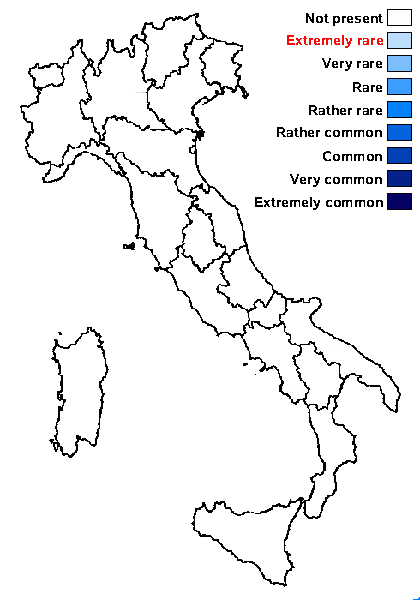Ingaderia sorediata (Sparrius, P. James & M.A. Allen) Ertz
Lichenologist, 55: 13, 2023. Basionym: Sclerophytonomyces circumscriptus var. sorediatus Sparrius, P. James & M.A. Allen - Lichenologist, 37: 285, 2005
Synonyms: Fulvophyton sorediatum (Sparrius, P. James & M.A. Allen) Tehler & van den Boom; Peterjamesia sorediata (Sparrius, P. James & M.A. Allen) D. Hawksw.; Roccellographa sorediata (Sparrius, P. James & M.A. Allen) Coppins & Fryday
Distribution:
Description: Thallus crustose, episubstratic, mosaic-forming, finely verrucose, milky white to pale grey, 0.2-0.3 mm thick, epruinose to densely white-pruinose, forming up to 5 cm wide, often confluent patches, usually delimited by a conspicuous, black, up to 2 mm wide prothallus. Soralia 0.5-2.5 mm across, irregular in shape, blue-grey or white, often widely confluent, the soredia 20-40 µm in diam. Cortex absent but a 20-30 µm thick gelatinous layer present; medulla chalky white, densely filled with calcium oxalate crystals. Apothecia extremely rare, black, immersed in the thallus, roundish (up to 0.7 mm across) to shortly lirellate (up to 1 x 0.5 mm). Proper exciple brownish black; hymenium colourless; paraphysoids branched and anastomosing, 1-2.5 μm thick, the apical cells often slightly enlarged; hypothecium colourless to dark brown. Asci 8-spored, narrowly clavate, not thickened near apex, with a small ocular chamber, the endoascus K/I+ blue, usually with an apical, K/I+ blue ring. Ascospores (4-)6-8-septate, hyaline but often turning brown at maturity, fusiform, 20-35 x 5-7 µm, straight to slightly curved, with a distinct, c. 3.5 µm thick gelatinous sheath. Photobiont trentepohlioid. Spot tests: thallus K± pale yellow, C- , KC-, P+ yellow, UV± pale cream. Chemistry: psoromic, ± conpsoromic acids.Note: a Mediterranean-Atlantic, mostly sterile species of sheltered siliceous rocks near the coast. The species is also known from Corsica, and should be looked for in Italy, especially in Sardinia and in the siliceous islands of the Tuscan Archipelago. For further details see Ertz & Tehler (2023).
Growth form: Crustose
Substrata: rocks
Photobiont: Trentepohlia
Reproductive strategy: mainly asexual, by soredia, or soredia-like structures (e.g. blastidia)
Restricted to humid-warm, oceanic areas
Taxon bound to maritime-coastal situations

Predictive model

Bernard Bouffinier - Source:http://www.lichensmaritimes.org/index.php?task=fiche&lichen=132&lang=en
France, Pointe du Raz
sorediate form corresponding to Peterjamesia sorediata

Alain Gerault - Source:http://www.lichensmaritimes.org/index.php?task=fiche&lichen=132&lang=en
France, Pointe du Van
sorediate form corresponding to Peterjamesia sorediata

Alain Gerault - Source:http://www.lichensmaritimes.org/index.php?task=fiche&lichen=132&lang=en
France, Pointe du Van
sorediate form corresponding to Peterjamesia sorediata

Alain Gerault - Source:http://www.lichensmaritimes.org/index.php?task=fiche&lichen=132&lang=en
France, Pointe du Raz
sorediate form corresponding to Peterjamesia sorediata

Bernard Bouffinier - Source:http://www.lichensmaritimes.org/index.php?task=fiche&lichen=132&lang=en
France, Pointe du Van
sorediate form corresponding to Peterjamesia sorediata

Bernard Bouffinier - Source:http://www.lichensmaritimes.org/index.php?task=fiche&lichen=132&lang=en
France, Pointe du Van
sorediate form corresponding to Peterjamesia sorediata
Growth form: Crustose
Substrata: rocks
Photobiont: Trentepohlia
Reproductive strategy: mainly asexual, by soredia, or soredia-like structures (e.g. blastidia)
Restricted to humid-warm, oceanic areas
Taxon bound to maritime-coastal situations

Predictive model

Bernard Bouffinier - Source:http://www.lichensmaritimes.org/index.php?task=fiche&lichen=132&lang=en
France, Pointe du Raz
sorediate form corresponding to Peterjamesia sorediata

Alain Gerault - Source:http://www.lichensmaritimes.org/index.php?task=fiche&lichen=132&lang=en
France, Pointe du Van
sorediate form corresponding to Peterjamesia sorediata

Alain Gerault - Source:http://www.lichensmaritimes.org/index.php?task=fiche&lichen=132&lang=en
France, Pointe du Van
sorediate form corresponding to Peterjamesia sorediata

Alain Gerault - Source:http://www.lichensmaritimes.org/index.php?task=fiche&lichen=132&lang=en
France, Pointe du Raz
sorediate form corresponding to Peterjamesia sorediata

Bernard Bouffinier - Source:http://www.lichensmaritimes.org/index.php?task=fiche&lichen=132&lang=en
France, Pointe du Van
sorediate form corresponding to Peterjamesia sorediata




